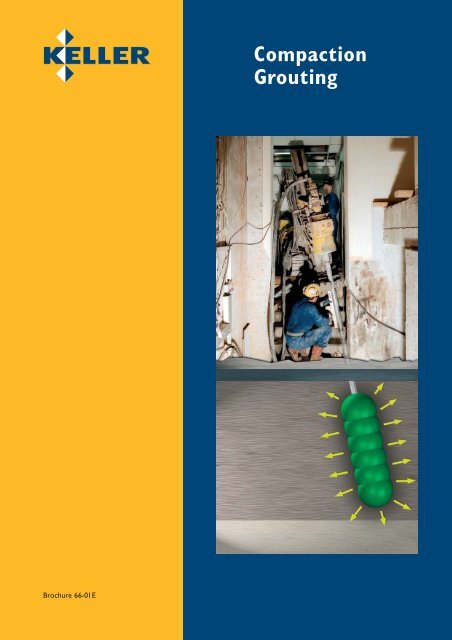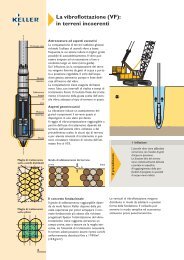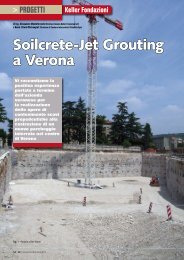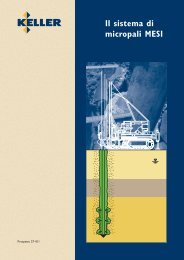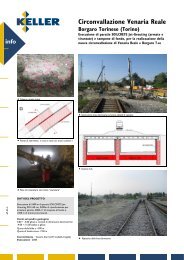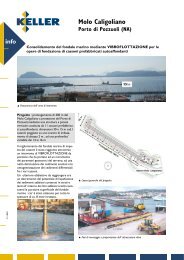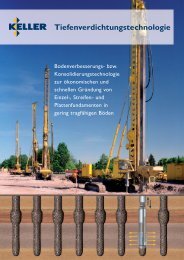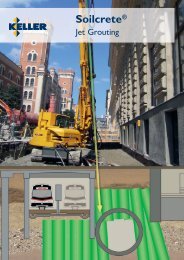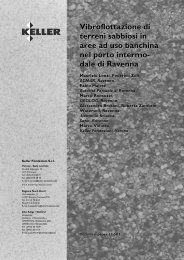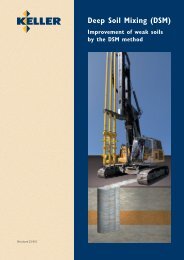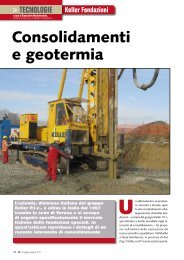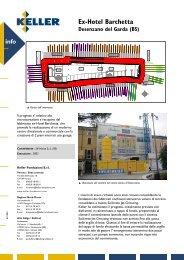Compaction Grouting - Keller Fondazioni SrL
Compaction Grouting - Keller Fondazioni SrL
Compaction Grouting - Keller Fondazioni SrL
- No tags were found...
Create successful ePaper yourself
Turn your PDF publications into a flip-book with our unique Google optimized e-Paper software.
Brochure 66-01E<strong>Compaction</strong><strong>Grouting</strong>
ContentsThe method on the market ...... 3Process description ..................... 4Soil improvement ........................ 6Foundation rehabilitation ........... 8Cavity grouting ........................... 102
DevelopmentThe compaction grouting process, which was first applied in the USA during the 1950ies and furtherdeveloped, mainly by engineers of Hayward Baker Inc., is gaining more and more acceptance in Europesince the beginning of the 1990ies.When <strong>Keller</strong> first applied this technique in Europe, we were able to build upon the rich experiencegained by our American sister company and since then have been continuously developing this process.Fields of application / Position on the marketWhile compaction grouting had originally been used only for the foundation rehabilitation of settlementsensitive structures, the field of application in the meantime has been extended. Nowadays this techniqueis used in various fields of application – which frequently can be combined in a single project.• Soil improvementImprovement of soils with insufficient bearing capacity, respectively with an increase in relative density,e.g. as an alternative or supplement to pile foundations or stone columns.• Stabilisation and rehabilitation of foundationsIncrease or restoration of the bearing capacity of the soil under an existing foundation, e.g. in cases ofincrease in load or settlement damages. This process is an alternative to Soilcrete ® or mini piles and/or serves as pre-treatment when applying the Soilcrete ® and Soilfrac ® process.• Cavity <strong>Grouting</strong>Force locking backfill of very porous soils, erosions or cavities, e.g. in backfilled areas which have notsufficiently been compacted, in karst, in case of damages caused by water pipes or below carriagewayslabs.This process constitutes a multi-purpose supplement to existing specialised ground engineeringtechniques and, in addition, can be combined with almost all known procedures.COMPACTION GROUTING TODAY3
The <strong>Compaction</strong> <strong>Grouting</strong> ProcessWhen applying the compaction grouting process usually a stiff to plastic grout is injectedinto the soil under pressure. It expands in the soil as a relatively homogeneous mass andat the same time is forming almost ball-shaped grout bulbs. The soil surrounding thegrouted area is displaced and at the same time compacted. Compared to other groutingtechniques, the grout material neither penetrates into the pores of the in-situ soil (as isthe case with the classical injection) nor are local cracks formed (as is the case with theSoilfrac ® technique).During the compaction grouting process pressure and grout quantity as well as possibledeformations at ground surface, respectively at structures are monitored. Depending onthe design requirements, the compaction grouting process will be terminated eitherwhen reaching a maximum pressure, a maximum grout volume, when achieving thedesired uplift of the structure or in case of grout material flowing out on the site surface.The execution method of the compaction grouting process is laid down in the EuropeanStandard EN 12 715.Range of ApplicationThe compaction grouting method may be used for the improvement of non-cohesivesoils, especially in cases, where soils of loose to medium density are encountered.This method is also used in fine-grained soils *) in order to install elements of higherstrength and bearing capacity in soils of low bearing capacity, thus improving the loadbearing behaviour of the soil.When using this technique in saturated clayey soil, a temporary increase of the porewater pressure can be observed.* Due to the fact that fine-grained soils cannot be compacted from the soil mechanics’ point of view –by applying the same technique – strictly speaking, consolidation grouting is carried out.TECHNIQUERange of Application for <strong>Grouting</strong> TechniquesTechniquesSoilcrete ® /Jet <strong>Grouting</strong>Soilfrac ® /Compensation <strong>Grouting</strong><strong>Compaction</strong> <strong>Grouting</strong>Ultra fine cementsWater-glass solution (low viscosity)Cement suspensionsClay Silt Sand Gravel Boulder10080604020Sieve pass [weight %]EconomicalUneconomical0,002 0,006 0,02 0,06 0,2 0,6 2,0 6,0 20 60Grain size [mmØ]01 Installation in a basement2 Installation next to anexisting building3 Installation on aconstruction site1 2 34
▲1 2 3GroutlocationMeasurementand qualitycontrol devicesDry pre-mixed groutMixer andpump1 Installation of the Grout PipeThe grout pipe is either installedby means of a drill rig or a vibrohammer, depending on the soil andon the treatment requirements.2 <strong>Compaction</strong> <strong>Grouting</strong>The grout paste is prepared in the mixingplant and pressed into the soil by means ofa custom-built grout pump.While gradually pulling or penetrating thegrout pipes, individual intersecting groutbulbs are consecutively formed, thus creatingcolumn shaped structural elements.3 Staged <strong>Compaction</strong>In order to achieve a uniformcompaction of the soil, theinjections are at first executed ina large primary grid, and may becompacted further by means of asecondary grid.Quality AssuranceEvaluationProgram: <strong>Compaction</strong> grouting (1.0.2)Inventory: 130569 Site:Lot: 0 Point: 52 1K1 Ref. No.: 1Date: 23.07.02 Time: 20:48:03 Interval: 2 secLegend:Dept.: Consultingand Developmentn100 10 20 30 40Time[sec]Depth[m]Grout pressure[bar]Grout volume[l/step]100 5 10 15 20 0 10 20 30 40 0 200 400 600210003Quality as well as suitability of the freshgrout is constantly assured by measuringits slump.20004530006The degree of compaction can becontrolled by the following parameters,depending on the requirements:• evaluation of the automaticallyrecorded process parameters bymeans of a <strong>Keller</strong> in-house software• deformation measurements atsite surface or structures• soundings (CPT, SPT) before andafter the compaction groutingprocess4000Point duration: 19,06 min Max. depth: 14,50 mM4-print out: depth, pressure and grout volumeare continuously recorded and shown on a timeaxis. Alternatively, recordings can be drawn on adepth axis.depth [m]789101112grouted section13Diagram of a penetrometer test(pre/post)prepost5
Ground ImprovementFrequently, soil improvement is necessary to increase the bearing capacity of poorsoils, in case of a structure which has been proposed to be founded on this soil.In addition to the deep vibro techniques (such as vibro compaction and vibroreplacement) which have been applied by <strong>Keller</strong> for decades, the compactiongrouting technique has proven to be a suitable alternative in many cases.For the execution of compaction grouting works a number of different drill rigsand and vibro hammers can be used. The execution method can therefore beeasily adapted to the prevailing local conditions.In principle, the compaction grouting technique can achieve a similar degree ofimprovement as by the deep vibro techniques.The compaction grouting method is particularly well suited as an alternative orsupplement to deep vibro techniques in the following cases:• confined working space• limited working height• vibration-free technique required (e.g. because of a highly sensitive structurein the vicinity)• compaction at very large depths• for intermittant strong soil layers, which cannot be penetrated by a depthvibrator, thus making its use inefficient.1COMPACTING4VisualisationEach working level is shown separatelyA Working level / gridB Pressure distributionC Quantity distributionD Injections2 3AB1 Exposed section of acompaction grout column2 Exposed compaction area3 Soil improvement for theconstruction of a newpower plant in Indonesia4 Modern software is usedfor simulation andvisualisationCD6
Foundation RehabilitationSubsoil and footing together form the foundation system. Detrimental externalinfluences and long-term processes which affect the subsoil conditions, are knownto lead occasionally to a reduction in the bearing capacity of a foundation.Structural modifications of existing buildings often require an increase of thebearing capacity of the foundation.In all these cases, the compaction grouting process can be sensibly applied fortarget-oriented rehabilitation of existing footings, in order to stop incompatiblesettlements and deformations and to reverse them, if necessary, or to increasethe bearing capacity of an existing foundation in a controlled manner.The compaction grouting process also has proven to be an excellent techniquefor underpinnings, in case of sensitive or non-homogeneous soil conditions areencountered or if the causes of the settlements could not exhaustively bedetermined.REHABILITATION1 131 Rehabilitation of a roadbridge after flood damage2 Rehabilitation of the footingsunder a residential building3 Improvement of the stabilityof a church4 Rehabilitation of a footingunderneath a historicalbuilding2bearing stratalow-strength soil8
Cavity <strong>Grouting</strong>With ressources becoming more and more scarce and prices for land increasing,it becomes increasingly necessary to build structures in areas, which werepreviously considered to be unsuitable for construction due to their poor soilproperties.In former mining regions, mining tailing backfills were for example sold as cheapconstruction lots after a certain rest period and are frequently used for theconstruction of industrial and commercial buildings.Due to the direct interaction between soil and grout material the compactiongrouting process is a particularly suitable technique to avoid or compensate nastysurprises as a result of unforeseen non-homogeneities or cavities occurring duringthe construction phase when building on poor soils of this kind.GROUTINGBefore treatment1 11 Soil improvement underthe slab of a multi-storeywarehouse underconstruction2 Improvement principle:compaction underneatha settled slabAfter treatmentSignificant compaction andincrease in stiffness of themining tailings achievingthe desired uniformity ofstrength, partial reversalof settlementsSoil Improvement2Staged compactionfrom bottom to topPrimary and intermediateinjections in a uniform gridSlabsettlement0,0 mCompactedgravel bed3,5 mMining tailingsNon-homogeneous,loose to very loose,timber and ironobstacles14,5 mNatural, cohesivesoil deposit10
111
<strong>Keller</strong> Grundbau GmbHInternational Geotechnical Contractorswww.<strong>Keller</strong>Grundbau.com · www.<strong>Keller</strong>-Asia.comGermanyHead Office and Overseas DivisionP.O. Box 10 06 6463006 OffenbachTel. +49 69 8051-0 · Fax +49 69 8051-270E-mail: Overseas@<strong>Keller</strong>Grundbau.comBahrain<strong>Keller</strong> Grundbau GmbHFlat 205, Bldg. 63 · P.O. Box 5452Manama 332Tel. +973 17741677 · Fax +973 17741688E-mail: <strong>Keller</strong>@batelco.com.bhU.A.E.<strong>Keller</strong> Grundbau GmbHOffice 208, 2 nd Floor · Moh’d Al Makhawi BuildingUmm Hureir Road · P.O. Box 11 13 23DubaiTel. +971 4 3355283 · Fax +971 4 3355278E-mail: <strong>Keller</strong>@emirates.net.aeSaudi Arabia<strong>Keller</strong> Turki Co. Ltd.P.O. Box 718Dammam 31421Tel. +966 3 8333997 · Fax +966 3 8335325E-mail: <strong>Keller</strong>-turki@atco.com.saEgyptGENCO · Geotechnical Engineering Contractor Ltd.462, Horreya Avenue, RoushdyAlexandriaTel. +20 3 5458443 · Fax +20 3 5427372E-mail: Genco-alx@link.netMalaysia<strong>Keller</strong> (M) Sdn. Bhd.No. 35, Kg PakarBatu 5, Jalan Sungei Besi57100 Kuala LumpurTel. +60 3 79802894 · Fax +60 3 79800349E-mail: info@keller.com.mySingapore<strong>Keller</strong> Foundations (S E Asia) Pte Ltd.25 International Buisiness Park#04-01 German CentreSingapore 609916Tel. +65 65 629012 · Fax +65 65 629014E-mail: <strong>Keller</strong>@singnet.com.sgIndia<strong>Keller</strong> Ground Engineering India Pvt. Ltd.2 Cenotaph Court, No. 28 Cenotaph RoadTeynampet, Chennai 600018Tel. +91 44 24334582 · Fax +91 44 24334584E-mail: info@kellerindia.comHong Kong<strong>Keller</strong> Grundbau GmbHNo. 272, San Hing TsuenLam Tei, Tuen MunNew Territories, Hong KongTel. +852 24659711 · Fax +852 24831814E-mail: kellerhk@netvigator.comKorea (Rep.)<strong>Keller</strong>-Tuksu Ltd.1688-1, Seochong-DongSeoul 137-882Tel. +82 2 34817901 · Fax +82 2 34817905E-mail: <strong>Keller</strong>-Tuksu@<strong>Keller</strong>Grundbau.comA company of <strong>Keller</strong> Group plc


